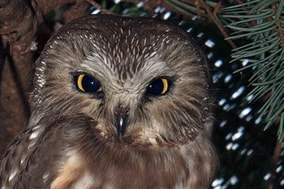 The day after the November election I was walking down the road and was dumbfounded to find a solitary wing and talon of an owl that had not been there 10 minutes earlier. Because the Saw Whet was the first of the road - killed owls I found thirty years ago, I recognized the wing pattern immediately. A single talon remained with the wing. Some avian predator had perhaps dropped the owl and then devoured most of it in the brief time since I had passed by. Distressed, I gathered up the wing and talon and brought it home, spreading out the beautiful little feathers into a fan and tacked it to the wall as a way to honor all owls. Saw-whet owls are native to this continent and one of the smallest owl species in North America. With the huge decline in bird species – a conservative estimate is that we have lost half of all our birds globally – it is not surprising that the Saw Whets have not escaped the ravages of Climate Change. They are listed as a “vulnerable” species, one notch down from endangered. Why is it that we don’t notice the diminishing of all species of birds unless we are especially attached to one? As a naturalist who can’t help but note the loss of so many non - human friends and feels such grief on a daily basis, I can’t wrap my mind around other people’s apparent indifference. Because it is January and most owls are beginning courtship this is the time to begin listening for owl calls. A couple of weeks ago I heard the triple hoo down by the water and was delighted. This is the first time I have heard the Saw Whet owl in many years. These little owls used to be quite common but are disappearing from all their ranges as previously mentioned. Habitat loss is the most common reason given, but I suspect Climate Change may be affecting the populations as well. They prefer forested areas so raging southwest fires, so called “controlled burning” and extensive logging have destroyed many of the places where Saw Whets breed. Curiously, these owls can be found across southern Canada and the northern and western United States, as well as in Mexico but the pattern of their migration is unknown. They seem to prefer mature forest with an open under story for foraging, deciduous trees for nesting, dense conifers for roosting, and like having a river or stream nearby. Saw Whets winter in dense forest throughout their breeding range and across most of the United States. Normally they do not breed in the far southern states although New Mexico is home to some. The Saw Whet owl has very sophisticated hearing due to having vertically asymmetrical ears and ear openings that are also a different shape. Because sound reaches the ears at a different time and is of different intensity, the Saw-Whet owl can very precisely localize its prey and can hunt by hearing alone. Saw-whet Owls eat mostly small mammals, hunting them at night from a low perch along the forest edge. The most common prey are deer mice, shrews, moles, voles, crayfish and frogs and the young of larger animals. They also eat beetles, grasshoppers, moths, and other insects (the ubiquitous irresponsible use of pesticides is another reason they are disappearing). This tiny owl with yellow eyes and a catlike face is a fierce hunter who will save part of its prey for a second meal, and if it freezes, will use its incubation skills to defrost dinner! During migration, Saw Whets supplement their diet with birds. Females probably choose the nest site, although males sometimes participate by perching in potential sites while giving their too-too-too call. Males provide nearly all of the food while females are incubating and brooding the young. Saw Whets prefer to nest in previously excavated holes - those of flickers or other woodpeckers provide wonderful homes. They gravitate to dead snags so please don’t cut yours down! They also use nest boxes, something my friend Barbara might consider. Saw-whets lay their 4 - 7 eggs on debris at the bottom of the cavity lined with woodchips, twigs, moss, grass, hair, and even small mammal bones. Nest holes may be 8–44 feet off the ground. The young fledge in about a month. Some year-round resident males or pairs probably maintain territories throughout the year, but each year these owls apparently pair up with new mates (there is just so much we don’t know). Saw Whets are preyed on by larger raptors, including Eastern Screech-Owls, Spotted Owls, Great Horned Owls, Cooper’s Hawks, Broad-winged Hawks, and Peregrine Falcons. They roost during the day in thick conifers and are mobbed by crows, ravens and even flocks of songbirds. In my opinion, paying attention to all this commotion is probably the best way to discover where any owl is hiding. If you are ever fortunate to meet a Saw Whet you are in for a treat because they are so cute! Because Saw Whets are strictly nocturnal they are seldom seen so it’s something of a mystery as to how I happened to come upon one during the day, even a dead one.
0 Comments
|
Submit your ideas for local feature articles
Profiles Gardening Recipes Observations Birding Essays Hiking AuthorsYou! Archives
October 2025
Categories
All
|
 RSS Feed
RSS Feed